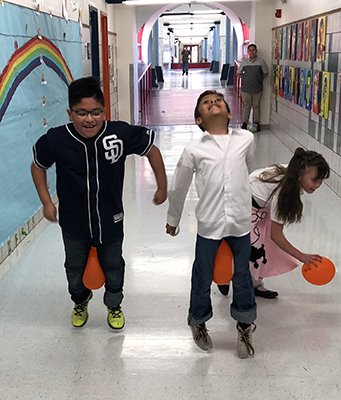Active Learning Opportunities
Incorporate physical activity before, during, and after the school day, as well as into daily lesson plans.
Read More Play is an essential part of development and offers children a chance to use their imagination to think outside of the box and discover new ways of thinking. Even on our best days, we sometimes find ourselves with limited time and on the move. Read on to learn more about three easy ways to incorporate play while on the go – whether its from classroom to classroom, in the car, or on a field trip.
Play is an essential part of development and offers children a chance to use their imagination to think outside of the box and discover new ways of thinking. Even on our best days, we sometimes find ourselves with limited time and on the move. Read on to learn more about three easy ways to incorporate play while on the go – whether its from classroom to classroom, in the car, or on a field trip.
Make transitions from one place to the next playful and engaging.
Traveling from one classroom to the next or while in the car is a great time to help children reset and refocus. Those 5-10 minutes can be brought to life with a fun activity to help students stay engaged that also doubles as a brain break – win, win! Try these ideas below and discover more with Playworks.
Put together busy bags or quiet bins.
Busy bags and quiet bins are an easy way to allow children to get creative, think outside the box and stay engaged during downtime in a way that is meaningful for them. These activities are nice because they can easily be transported, all of the materials needed are in one place, and they can be anything you want them to be. These can be used during free time in the classroom, in the car, and at home after school before dinner.
Go on an adventure story.
The next time you are walking to the park or playground, turn it into make-believe action! Encourage children to begin a story and play along with new twists and turns. You can use this time to tie in physical activity (“Hop on one foot until we reach the bridge.”) and subjects being studied (“That bee is taking something from that flower… do you know what it is?”).
Starting small is okay! Start with classroom goals and then widen to a school-wide initiative to add more playful time into the day.
Think of safety first! Be sure any routes you use are safe for children and there is adequate supervision based on the group size.
If implementing these activities in school, create a take home summary or worksheet that give parents the opportunity to replicate. Encourage conversations around the importance of playful learning and unstructured time and look to parents to share what other activities have worked for them.
Incorporate activities like these throughout the day at school and at home to improve focus and help children be creative.
Categories: Social-Emotional Health, At Home, At School, Digital Resource